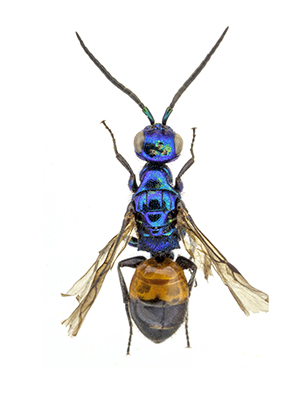Last updated on November 28th, 2023
 From: Kimsey L.S. & Bohart R.M., 1990 (1991) – The chrysidid wasps of the world. Oxford University Press, ix-652 pp.
From: Kimsey L.S. & Bohart R.M., 1990 (1991) – The chrysidid wasps of the world. Oxford University Press, ix-652 pp.
Synonymy
Cleptes Latreille 1802:316. Type: Sphex semiaurata Linnaeus 1761. Monobasic.
Lustrina Kurian 1955:86. Type: Lustrina assamensis Kurian 1955:87. Monobasic. New synonymy.
Cleptes (Holcocleptes) Móczár 1962:118. Type: Cleptes aerosus Förster 1853. Monobasic and orig. desig.
Cleptes (Leiocleptes) Móczár 1962:118. Type: Cleptes nitidulus Fabricius 1793. Orig. desig.
Cleptes (Zimmermannia) Móczár 1962:120. Type: Cleptes ignitus Fabricius 1787. Orig. desig.
Cleptes (Melanocleptes) Móczár 1962:122. Type: Cleptes morawitzi Radoszkowsky 1877. Orig. desig.
Cleptes (Chrysocleptes) Móczár 1962:122. Type: Cleptes putoni Buysson 1886. Orig. desig.
Cleptes (Oxycleptes) Móczár 1962:124. Type: Cleptes orientalis Dahlbom 1854. Monobasic and orig. desig.
Cleptes (Neocleptes) Kimsey 1981:816. Type: Cleptes fritzi Kimsey 1981. Monobasic and orig. desig.
Generic diagnosis
Head as wide as long or longer; eyes small, following head contour, not bulging; mid ocellus equal to or smaller than antennal socket; malar space usually more than 1 MOD; mandibles generally robust, with three or more apical teeth; mesopleuron with scrobe, scrobal sulcus, and omaulus present in some species; metanotum weakly obtuse or flat in profile; propodeal tooth triangular and generally shorter than broad; tarsal claws with one perpendicular submedial tooth fore wing discoidal cell indicated by stained vein remnants.
Hosts
These wasps are parasites of tenthredinid sawflies. In North America Smith (1962) reared specious (as provancheri) from Neodiprion sp., Dahlsten (1961, 1967) reared purpuratus from Neodiprion sp., and Darling and Smith (1985) reared semiauratus from Nematus hispidae Smith. In Europe Gauss (1964) reared semiauratus from Nematus sp. and Pristophora sp. Mocsary (1889) listed Nematus ribesii Scopoli as the host of nitidulus and semiauratus.
Distribution
Cleptes is primarily a Holarctic genus, with 46 species in Europe and 8 in North America. One European species, semiauratus, has become established in the north-eastern United States. In addition, there is one species in Argentina and eight in Asia, occurring as far south as Vietnam.
Discussion
Since the time of Dahlbom, Cleptes was thought to consist of two major groups; species with metallic coloration, Cleptes s. s. and non-metallic species, Heterocoelia-types (Dalla Torre 1892; Mocsáry 1889; Linsenmaier 1959a). Móczár (1951, 1962) did not mention Heterocoelia nigriventris Dahlbom. Obviously, none of the first three authors ever examined the type of this genus. However, Móczár did see the type. This species is not a chrysidid, but belongs in the bethylid subfamily Mesitiinae, as discussed by Móczár (1971).
Cleptes is the largest and most widespread of the cleptine genera, including 69 species. Móczár (1962) and Kimsey (1981) divided the genus into eight subgenera. Re-examination of Cleptes on a world basis indicates that these subgeneric groupings are far from discrete, particularly when the Asian species are considered. For this reason we synonymize the subgenera and, instead, divide Cleptes into species groups.
These groupings are based to a large extent on the descriptions of Móczár (1951, 1962), Tsuneki (1959), and Linsenmaier (1959a, 1968) as we have not been able to see many of the types. As a result, further study may indicate the need for more species groups than given here, and some groupings may also prove to be artificial.
European species
- Cleptes aerosus Förster, 1853
- Cleptes afer Lucas, 1849
- Cleptes cavernalis Móczár, 1968
- Cleptes femoralis Mocsáry, 1889
- Cleptes graecus Móczár, 2001
- Cleptes hungaricus Móczár, 2009
- Cleptes ignitus (Fabricius, 1787)
- Cleptes jungeri Linsenmaier, 1994
- Cleptes maculatus Linsenmaier, 1968
- Cleptes mocsaryi Semenow, 1891
- Cleptes Móczári Linsenmaier, 1968
- Cleptes nigritus Mercet, 1904
- Cleptes nigritus rhodosensis Móczár, 2000
- Cleptes nitidulus (Fabricius, 1793)
- Cleptes nyonensis Móczár, 1997
- Cleptes obsoletus Semenov, 1891
- Cleptes orientalis Dahlbom, 1854
- Cleptes pallipes Lepeletier, 1806
- Cleptes parnassicus Mocsáry, 1902
- Cleptes pseudosulcatus Móczár, 1968
- Cleptes putoni Buysson, 1886
- Cleptes schmidti Linsenmaier, 1986
- Cleptes scutellaris Mocsáry, 1889
- Cleptes semiauratus (Linnaeus, 1761)
- Cleptes semicyaneus Tournier, 1879
- Cleptes splendidus (Fabricius, 1794)
- Cleptes triestensis Móczár, 2000
Copyright, Authorship, and Ownership statements
All text and images of this page are copyright ©️ Chrysis.net unless otherwise stated - please see individual cases for authorship and copyright details. The specimens pictured are from the authors' or other collaborators' personal collections and from the collections of various museums. Unless otherwise specified, the whole content of this web site is for personal, non-commercial, scientific, and educational purposes given proper accreditation to the page from which they were derived are provided, and under Chrysis.net Terms and Conditions.
For citation purposes
Agnoli G.L. & Rosa P. (2025) Genus Cleptes Latreille, 1802, in: Chrysis.net website. Interim version 01 April 2025, URL: https://www.chrysis.net/database/genus-cleptes/.




